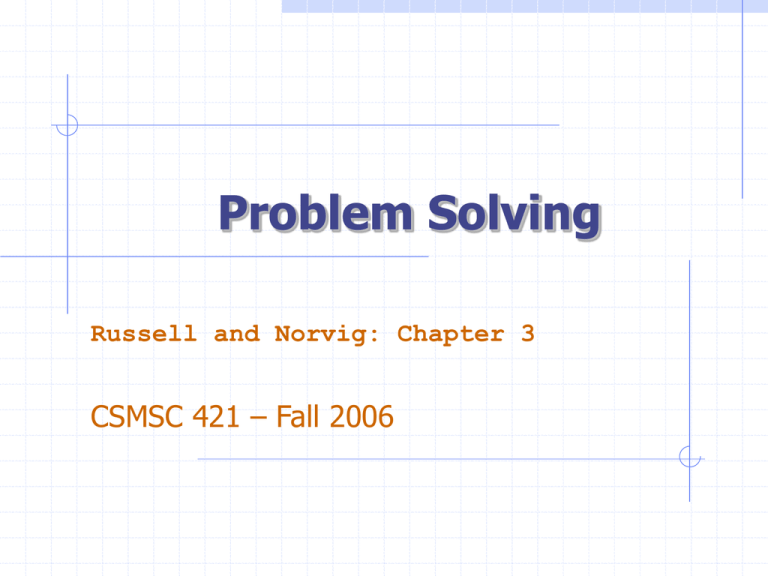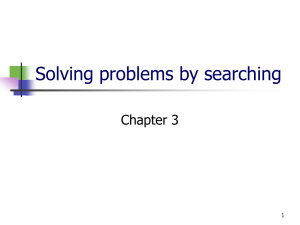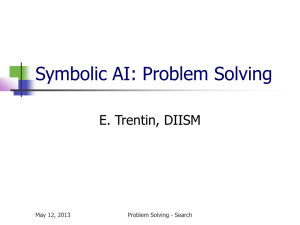Solving Problems by Searching
advertisement

Problem Solving
Russell and Norvig: Chapter 3
CSMSC 421 – Fall 2006
Problem-Solving Agent
sensors
?
environment
agent
actuators
Problem-Solving Agent
sensors
?
environment
agent
actuators
• Formulate Goal
• Formulate Problem
•States
•Actions
• Find Solution
Example: Route finding
Holiday Planning
On holiday in Romania; Currently in Arad.
Flight leaves tomorrow from Bucharest.
Formulate Goal:
Be in Bucharest
Formulate Problem:
States: various cities
Actions: drive between cities
Find solution:
Sequence of cities: Arad, Sibiu, Fagaras, Bucharest
Problem Solving
States
Actions
Start
Solution
Goal
Vacuum World
Problem-solving agent
Four general steps in problem solving:
Goal formulation
What are the successful world states
Problem formulation
What actions and states to consider given the goal
Search
Determine the possible sequence of actions that lead to
the states of known values and then choosing the best
sequence.
Execute
Give the solution perform the actions.
Problem-solving agent
function SIMPLE-PROBLEM-SOLVING-AGENT(percept) return an action
static: seq, an action sequence
state, some description of the current world state
goal, a goal
problem, a problem formulation
state UPDATE-STATE(state, percept)
if seq is empty then
goal FORMULATE-GOAL(state)
problem FORMULATE-PROBLEM(state,goal)
seq SEARCH(problem)
action FIRST(seq)
seq REST(seq)
return action
Assumptions Made (for now)
The
The
The
The
environment is static
environment is discretizable
environment is observable
actions are deterministic
Problem formulation
A problem is defined by:
An initial state, e.g. Arad
Successor function S(X)= set of action-state pairs
e.g. S(Arad)={<Arad Zerind, Zerind>,…}
intial state + successor function = state space
Goal test, can be
Explicit, e.g. x=‘at bucharest’
Implicit, e.g. checkmate(x)
Path cost (additive)
e.g. sum of distances, number of actions executed, …
c(x,a,y) is the step cost, assumed to be >= 0
A solution is a sequence of actions from initial to goal state.
Optimal solution has the lowest path cost.
Selecting a state space
Real world is absurdly complex.
State space must be abstracted for problem solving.
State = set of real states.
Action = complex combination of real actions.
e.g. Arad Zerind represents a complex set of possible
routes, detours, rest stops, etc.
The abstraction is valid if the path between two states is
reflected in the real world.
Solution = set of real paths that are solutions in the
real world.
Each abstract action should be “easier” than the real
problem.
Example: vacuum world
States??
Initial state??
Actions??
Goal test??
Path cost??
Example: vacuum world
States?? two locations with or without dirt: 2 x 22=8
states.
Initial state?? Any state can be initial
Actions?? {Left, Right, Suck}
Goal test?? Check whether squares are clean.
Path cost?? Number of actions to reach goal.
Example: 8-puzzle
States??
Initial state??
Actions??
Goal test??
Path cost??
Example: 8-puzzle
States?? Integer location of each tile
Initial state?? Any state can be initial
Actions?? {Left, Right, Up, Down}
Goal test?? Check whether goal configuration is
reached
Path cost?? Number of actions to reach goal
Example: 8-puzzle
8
2
3
4
5
1
1
2
3
7
4
5
6
6
7
8
Initial state
Goal state
Example: 8-puzzle
8
2
3
4
7
5
1
6
8
2
3
4
5
1
8
7
6
2
8
2
3
4
7
3
4
7
5
1
6
5
1
6
Example: 8-puzzle
Size of the state space = 9!/2 = 181,440
15-puzzle .65 x 1012
0.18 sec
6 days
24-puzzle .5 x 1025
12 billion years
10 million states/sec
Example: 8-queens
Place 8 queens in a chessboard so that no two queens
are in the same row, column, or diagonal.
A solution
Not a solution
Example: 8-queens problem
Incremental formulation vs. complete-state formulation
States??
Initial state??
Actions??
Goal test??
Path cost??
Example: 8-queens
Formulation #1:
•States: any arrangement of
0 to 8 queens on the board
• Initial state: 0 queens on the
board
• Actions: add a
queen in any square
• Goal test: 8 queens on the
board, none attacked
• Path cost: none
648 states with 8 queens
Example: 8-queens
2,067 states
Formulation #2:
•States: any arrangement of
k = 0 to 8 queens in the k
leftmost columns with none
attacked
• Initial state: 0 queens on the
board
• Successor function: add a
queen to any square in the
leftmost empty column such
that it is not attacked
by any other queen
• Goal test: 8 queens on the
board
Real-world Problems
Route finding
Touring problems
VLSI layout
Robot Navigation
Automatic assembly sequencing
Drug design
Internet searching
…
Example: robot assembly
States??
Initial state??
Actions??
Goal test??
Path cost??
Example: robot assembly
States?? Real-valued coordinates of robot joint
angles; parts of the object to be assembled.
Initial state?? Any arm position and object
configuration.
Actions?? Continuous motion of robot joints
Goal test?? Complete assembly (without robot)
Path cost?? Time to execute
Basic search algorithms
How do we find the solutions of previous
problems?
Search the state space (remember complexity of
space depends on state representation)
Here: search through explicit tree generation
ROOT= initial state.
Nodes and leafs generated through successor function.
In general search generates a graph (same state
through multiple paths)
Simple Tree Search Algorithm
function TREE-SEARCH(problem, strategy) return solution
or failure
Initialize search tree to the initial state of the problem
do
if no candidates for expansion then return failure
choose leaf node for expansion according to strategy
if node contains goal state then return solution
else expand the node and add resulting nodes to the
search tree
enddo
Exercise #1: Getting an Intro
Aka: the art of schmoozing…
Take home points
Difference between State Space and
Search Tree
Search of State Space
Search of State Space
Search State Space
Search of State Space
Search of State Space
Search of State Space
search tree
Take home points
Difference between State Space and
Search Tree
Blind Search
Learn names,
State space vs. search tree
A state is a (representation of) a physical configuration
A node is a data structure belong to a search tree
A node has a parent, children, … and ncludes path cost, depth,
…
Here node= <state, parent-node, action, path-cost, depth>
FRINGE= contains generated nodes which are not yet
expanded.
Tree search algorithm
function TREE-SEARCH(problem,fringe) return a solution or
failure
fringe INSERT(MAKE-NODE(INITIAL-STATE[problem]),
fringe)
loop do
if EMPTY?(fringe) then return failure
node REMOVE-FIRST(fringe)
if GOAL-TEST[problem] applied to STATE[node] succeeds
then return SOLUTION(node)
fringe INSERT-ALL(EXPAND(node, problem), fringe)
Tree search algorithm (2)
function EXPAND(node,problem) return a set of nodes
successors the empty set
for each <action, result> in SUCCESSOR-FN[problem](STATE[node]) d
s a new NODE
STATE[s] result
PARENT-NODE[s] node
ACTION[s] action
PATH-COST[s] PATH-COST[node] + STEP-COST(node, action,s)
DEPTH[s] DEPTH[node]+1
add s to successors
return successors
Search Strategies
A strategy is defined by picking the order of node
expansion
Performance Measures:
Completeness – does it always find a solution if one exists?
Time complexity – number of nodes generated/expanded
Space complexity – maximum number of nodes in memory
Optimality – does it always find a least-cost solution
Time and space complexity are measured in terms of
b – maximum branching factor of the search tree
d – depth of the least-cost solution
m – maximum depth of the state space (may be ∞)
Uninformed search strategies
(a.k.a. blind search) = use only information available
in problem definition.
When strategies can determine whether one non-goal
state is better than another informed search.
Categories defined by expansion algorithm:
Breadth-first search
Uniform-cost search
Depth-first search
Depth-limited search
Iterative deepening search.
Bidirectional search
Breadth-First Strategy
Expand shallowest unexpanded node
Implementation: fringe is a FIFO queue
New nodes are inserted at the end of the queue
1
2
4
8
FRINGE = (1)
3
5
6
9
7
Breadth-First Strategy
Expand shallowest unexpanded node
Implementation: fringe is a FIFO queue
New nodes are inserted at the end of the queue
1
2
4
8
FRINGE = (2, 3)
3
5
6
9
7
Breadth-First Strategy
Expand shallowest unexpanded node
Implementation: fringe is a FIFO queue
New nodes are inserted at the end of the queue
1
2
4
8
FRINGE = (3, 4, 5)
3
5
6
9
7
Breadth-First Strategy
Expand shallowest unexpanded node
Implementation: fringe is a FIFO queue
New nodes are inserted at the end of the queue
1
2
4
8
FRINGE = (4, 5, 6, 7)
3
5
6
9
7
Breadth-First Strategy
Expand shallowest unexpanded node
Implementation: fringe is a FIFO queue
New nodes are inserted at the end of the queue
1
2
4
8
FRINGE = (5, 6, 7, 8)
3
5
6
9
7
Breadth-First Strategy
Expand shallowest unexpanded node
Implementation: fringe is a FIFO queue
New nodes are inserted at the end of the queue
1
2
4
8
FRINGE = (6, 7, 8)
3
5
6
9
7
Breadth-First Strategy
Expand shallowest unexpanded node
Implementation: fringe is a FIFO queue
New nodes are inserted at the end of the queue
1
2
4
8
FRINGE = (7, 8, 9)
3
5
6
9
7
Breadth-First Strategy
Expand shallowest unexpanded node
Implementation: fringe is a FIFO queue
New nodes are inserted at the end of the queue
1
2
4
8
FRINGE = (8, 9)
3
5
6
9
7
Breadth-first search: evaluation
Completeness:
Does it always find a solution if one exists?
YES
If shallowest goal node is at some finite depth d
Condition: If b is finite
(maximum num. of succ. nodes is finite)
Breadth-first search: evaluation
Completeness:
YES (if b is finite)
Time complexity:
Assume a state space where every state has b
successors.
root has b successors, each node at the next level has
again b successors (total b2), …
Assume solution is at depth d
Worst case; expand all but the last node at depth d
Total numb. of nodes generated:
1 + b + b2 + … + bd + b(bd-1) = O(bd+1)
Breadth-first search: evaluation
Completeness:
YES (if b is finite)
Time complexity:
Total numb. of nodes generated:
1 + b + b2 + … + bd + b(bd-1) = O(bd+1)
Space complexity:O(bd+1)
Breadth-first search: evaluation
Completeness:
YES (if b is finite)
Time complexity:
Total numb. of nodes generated:
1 + b + b2 + … + bd + b(bd-1) = O(bd+1)
Space complexity:O(bd+1)
Optimality:
Does it always find the least-cost solution?
In general YES
unless actions have different cost.
Breadth-first search: evaluation
lessons:
Memory requirements are a bigger problem than execution time.
Exponential complexity search problems cannot be solved by
uninformed search methods for any but the smallest instances.
DEPTH
NODES
TIME
MEMORY
2
1100
0.11 seconds
1 megabyte
4
111100
11 seconds
106
megabytes
6
107
19 minutes
10 gigabytes
8
109
31 hours
1 terabyte
10
1011
129 days
101 terabytes
12
1013
35 years
10 petabytes
14
1015
3523 years
1 exabyte
Assumptions: b = 10; 10,000 nodes/sec; 1000 bytes/node
Uniform-cost search
Extension of BF-search:
Expand node with lowest path cost
Implementation: fringe = queue ordered by path
cost.
UC-search is the same as BF-search when all stepcosts are equal.
Uniform-cost search
Completeness:
YES, if step-cost > (smal positive constant)
Time complexity:
Assume C* the cost of the optimal solution.
Assume that every action costs at least
Worst-case:
C */
O(b
)
Space complexity:
Idem to time complexity
Optimality:
expanded in order of increasing path cost.
nodes
YES, if complete.
Depth-First Strategy
Expand deepest unexpanded node
Implementation: fringe is a LIFO queue (=stack)
1
2
4
FRINGE = (1)
5
3
Depth-First Strategy
Expand deepest unexpanded node
Implementation: fringe is a LIFO queue (=stack)
1
2
4
FRINGE = (2, 3)
5
3
Depth-First Strategy
Expand deepest unexpanded node
Implementation: fringe is a LIFO queue (=stack)
1
2
4
FRINGE = (4, 5, 3)
5
3
Depth-First Strategy
Expand deepest unexpanded node
Implementation: fringe is a LIFO queue (=stack)
1
2
4
3
5
Depth-First Strategy
Expand deepest unexpanded node
Implementation: fringe is a LIFO queue (=stack)
1
2
4
3
5
Depth-First Strategy
Expand deepest unexpanded node
Implementation: fringe is a LIFO queue (=stack)
1
2
4
3
5
Depth-First Strategy
Expand deepest unexpanded node
Implementation: fringe is a LIFO queue (=stack)
1
2
4
3
5
Depth-First Strategy
Expand deepest unexpanded node
Implementation: fringe is a LIFO queue (=stack)
1
2
4
3
5
Depth-First Strategy
Expand deepest unexpanded node
Implementation: fringe is a LIFO queue (=stack)
1
2
4
3
5
Depth-First Strategy
Expand deepest unexpanded node
Implementation: fringe is a LIFO queue (=stack)
1
2
4
3
5
Depth-First Strategy
Expand deepest unexpanded node
Implementation: fringe is a LIFO queue (=stack)
1
2
4
3
5
Depth-First Strategy
Expand deepest unexpanded node
Implementation: fringe is a LIFO queue (=stack)
1
2
4
3
5
Depth-First Strategy
Expand deepest unexpanded node
Implementation: fringe is a LIFO queue (=stack)
1
2
4
3
5
Depth-first search: evaluation
Completeness;
Does it always find a solution if one exists?
NO
unless search space is finite and no loops are
possible.
Depth-first search: evaluation
Completeness;
NO unless search space
is finite.
m
O(b )
Time complexity;
Terrible if m is much larger than d (depth of
optimal solution)
But if
many solutions, then faster than BFS
Depth-first search: evaluation
Completeness;
NO unless search space is finite.
Time complexity;O(b m )
Space complexity; O(bm 1)
Backtracking search uses even less memory
One
successor instead of all b.
Depth-first search: evaluation
Completeness;
NO unless search space is finite.
Time complexity; O(b m )
Space complexity; O(bm 1)
Optimality; No
Depth-Limited Strategy
Depth-first with depth cutoff k (maximal depth below
which nodes are not expanded)
Three possible outcomes:
Solution
Failure (no solution)
Cutoff (no solution within cutoff)
Solves the infinite-path problem.
If k< d then incompleteness results.
If k> d then not optimal.
Time complexity: O(bk)
Space complexity O(bk)
Iterative Deepening Strategy
Repeat for k = 0, 1, 2, …:
Perform depth-first with depth cutoff k
Complete
Optimal if step cost =1
Time complexity is:
(d+1)(1) + db + (d-1)b2 + … + (1) bd = O(bd)
Space complexity is: O(bd)
Comparison of Strategies
Breadth-first is complete and optimal,
but has high space complexity
Depth-first is space efficient, but neither
complete nor optimal
Iterative deepening combines benefits
of DFS and BFS and is asymptotically
optimal
Bidirectional Strategy
2 fringe queues: FRINGE1 and FRINGE2
Time and space complexity = O(bd/2) << O(bd)
The predecessor of each node should be efficiently computable.
Summary of algorithms
Criterion
BreadthFirst
Uniformcost
DepthFirst
Depthlimited
Iterative
deepening
Bidirectio
nal search
Complete
?
YES*
YES*
NO
YES,
if l d
YES
YES*
Time
bd+1
bC*/e
bm
bl
bd
bd/2
Space
bd+1
bC*/e
bm
bl
bd
bd/2
Optimal?
YES*
YES*
NO
NO
YES
YES
Repeated states
Failure to detect repeated states can turn a solvable problems
into unsolvable ones.
Avoiding Repeated States
Requires comparing state descriptions
Breadth-first strategy:
Keep track of all generated states
If the state of a new node already exists,
then discard the node
Avoiding Repeated States
Depth-first strategy:
Solution 1:
Keep track of all states associated with nodes in current
tree
If the state of a new node already exists, then discard
the node
Avoids loops
Solution 2:
Keep track of all states generated so far
If the state of a new node has already been generated,
then discard the node
Space complexity of breadth-first
Graph search algorithm
Closed list stores all expanded nodes
function GRAPH-SEARCH(problem,fringe) return a solution or failure
closed an empty set
fringe INSERT(MAKE-NODE(INITIAL-STATE[problem]), fringe)
loop do
if EMPTY?(fringe) then return failure
node REMOVE-FIRST(fringe)
if GOAL-TEST[problem] applied to STATE[node] succeeds
then return SOLUTION(node)
if STATE[node] is not in closed then
add STATE[node] to closed
fringe INSERT-ALL(EXPAND(node, problem), fringe)
Graph search, evaluation
Optimality:
GRAPH-SEARCH discard newly discovered paths.
This may result in a sub-optimal solution
YET: when uniform-cost search or BF-search with constant step cost
Time and space complexity,
proportional to the size of the state space
(may be much smaller than O(bd)).
DF- and ID-search with closed list no longer has linear space
requirements since all nodes are stored in closed list!!
Summary
Problem Formulation: state space, initial
state, successor function, goal test, path cost
Search tree state space
Evaluation of strategies: completeness,
optimality, time and space complexity
Uninformed search strategies: breadth-first,
depth-first, and variants
Avoiding repeated states





